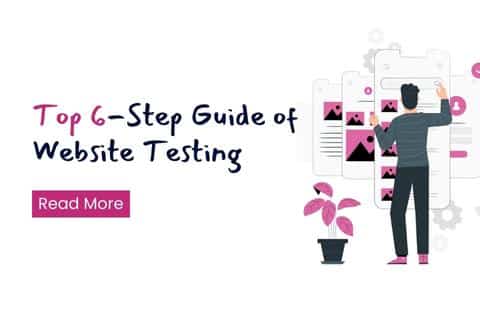- December 13, 2022
- techAdmin
- 0
Top 6-Step Guide of Website Testing for Beginners
Almost every business today runs online. A digital presence is one of the most accessible ways companies can reach users and customers. Websites are great for impressing customers. So, when building a website for your business, you must make it the best version.
You must test your websites and fix any issues to ensure that your website is good enough to attract customers and avoid any negative impact. So, in this blog, we are discussing the six steps to test your website.
A website is at the forefront of the internet world for any online business—nearly five billion people use the internet every day worldwide. The massive volume of online companies and services can reach a broader audience because of the volume of active web users.
Regardless of a website’s purpose or services, the success of any site is significantly dependent on the user experience and performance it provides.
Why is Website Testing necessary?
A single anomaly in the user journey might cause a user to bounce or lose revenue if they have a short attention span. Therefore, every online business should conduct a thorough website quality assurance test.
We can testify to this by looking at some statistics that demonstrate the importance of website testing:
- In one-third of cases, customers will stop interacting with a website due to a terrible user experience.
- 57% of users recommend a business with a mobile-friendly website.
- 88% of online customers said they are less likely to return to a website if they’ve had a negative experience in the first place.
Here’s where website testing of a website plays a vital role in delivering a reliable, bug-free, and intuitive user experience.
The top 6-Step Guide to Website Testing

When testing a website, you have to check for many things. This checklist can be divided into six significant steps as follows:
- Functionality testing
- Usability testing
- Interface testing
- Compatibility testing
- Performance testing
- Security testing
- Functionality Testing
The first thing you need to check on your website is to ensure it is doing the task it was built for. When you create a website, you have a purpose for that application.
All links should also test all the links in the website to ensure they are effective. Outgoing links to other websites and internal links are examples of these links connecting to another page on the same website.
The website includes forms where users can enter data. Their name, contact information, Etc., could be the data. If there are mandatory fields in the state, you have to ensure that the website submits the form with those fields.
Suppose you’re using input validation, for example, to check whether an email address is valid. In that case, you’ll have to make validation checks.
If your website show users custom data, you must ensure that the cookies are handled correctly. One of the basic tests for a dynamic website is ensuring that the custom data displayed is unique to the person looking at it. You test the website’s functionality in functionality testing. Works from end to end.
Usability Testing
The whole point of building a website for your business is to impress your customers. Usability testing is where you consider user experience while using your website. This Testing is the step in determining how user-friendly your website is.
You’ll test the user’s ease of use. Use your features and navigate through them. You also have to ensure that your website’s contents are easily visible.
Interface Testing
A typical website has three main components: a web browser used by a user to communicate with the server, a database, and a web server that manages the website functions.
Interface testing examines the database, web browser, and web server’s communication.
When you test an interface, you ensure that these three parts communicate correctly. It helps you determine whether the transmitted data safely reaches its destination.
Testing for data transfer interruptions is also included in this. It ensures smooth communication between the interfaces.
Compatibility Testing
Compatibility testing is the step where you determine whether your web application functions correctly on various devices. Compatibility testing can be broken down into three main categories:
- Browser compatibility
- Operating system compatibility
- Device compatibility
Browser Compatibility
There are multiple browsers available today. You have Google Chrome, Firefox, Opera, and others, to name a few. Any of these browsers may be used by your application’s users. It would help if you guaranteed that your application runs with no issues on every one of them.
Operating System Compatibility
Similar to web browsers, many operating systems are in the world. Suppose your website can communicate with the operating system it is running on. Verifying that it functions properly across all operating systems is essential.
Device Compatibility
Numerous devices exist as a result of the electronic industry’s ongoing innovation. Even though these devices are popular, they cause developers headaches because they have to design applications to use these new gadgets, like laptops, smartphones, tablets, Etc. You must test your website to ensure that it works on many devices.
Performance Testing
There will be times when you develop your website online when it attracts many clients in light of what’s going on out on the planet or recent developments.
For instance, when an e-commerce site has a Christmas sale, it will receive more traffic than on any other day. Make sure your website can handle this amount of traffic by testing it.
You put stress on the website to prepare it for that. You push it as far as possible and perceive how it answers. After that, once you’ve reached it, you can choose whether to upgrade it for the breaking point of increased dependability or whether the current setup is adequate.
While testing your application, you need to deal with the essentials of execution testing.
Security Testing
One of the essential features of any website is security. When you construct a website, you’ll store a ton of client and website information. Sensitive information might be in this data. You must ensure that your website is safe and resistant to hacking.
The stage where you discover your website’s weak security points is security testing. There are numerous ways of doing this: The most common methods include ethical hacking, automated security testing, and penetration testing.
Get into the Point
You are responsible for creating the best product as a website developer or tester. How to become a good website developer, as professional website tester. You will need to test your website for various things to determine how far it needs to go to be at its best. This post’s six steps cover the most important aspects for which you should test and improve your website.
Your website will benefit significantly from iterative Testing. While the developers or quality assurance staff can handle the preliminary tests for these six aspects, dedicated teams are required for intensive Testing. Yet, that again relies upon the prerequisites of the application.
That concludes this blog. Suppose you want to simplify your website development. In that case, you can also check out Retrace, an excellent tool for improving website quality and performance from the best website development agency.

